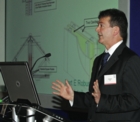CIBSE conference gives foretaste of 2010 Building Regulations

The levels of reductions in carbon emissions that leading lights in the building-services industry have considered possible and desirable for some time could become a reality with the publication of the 2010 Building Regulations.
The rules about how much Britain’s carbon emissions should be reduced by, and when, are changing all the time — and becoming more demanding. Only very recently, the Government raised the target for reducing carbon emissions from 60% to 80% by 2050, compared with 1990 — adding the scope for lots more debate at the recent CIBSE conference ‘Engineering excellence: the way to a sustainable business’. That 80% figure is a legal obligation on Government. On the way to 2050 is a 30% reduction by 2020 and zero-carbon for new houses by 2016.
Buildings, as we are all well aware, are responsible for about half the UK’s carbon emissions. Achieving the reduction targets is therefore within the responsibility and expertise of building-services engineers. On the way to achieving those targets, they are increasingly enjoying the support of Building Regulations, which first introduced Part L on the use of energy in buildings in 2002 and reinforced it with the 2006 revision.
The next update of the Building Regulations is due in 2010, and is now at the consultation stage. Paul DeCort, principal building services professional at the Department for Communities & Local Government (CLG) gave an insight into Government thinking and the direction the 2010 Building Regulations are moving.
Ambitions include a timetable for all new non-domestic buildings to become zero carbon by 2019. The date for schools is 2016, followed by public buildings in 2018 and all other non-domestic buildings by 2019.
Unfortunately, even by 2050, only 30% of a larger building stock will have been built after 2005, and the rate of demolition is so low that by 2050 the pre-2005 stock will have been reduced by less than 10%. The 2010 review therefore gives much attention to existing buildings.
The basis of the 2010 review for new buildings is a further 25% reduction over the 2006 Building Regulations — an overall improvement of 44% on the 2002 regulations.
An important proposed change for 2010 over 2006 is how the 25% reduction will be achieved.
In 2006, the reduction in carbon emissions was based partly on how the building was serviced, quickly leading some people to identify unintended consequences — such as it being far easier to achieve a compliant air-conditioned building than a naturally ventilated one. The problem was explained in detail by Prof. Terry Payne of Monodraught in Modern Building Services last year.
The requirement of the current Building Regulations is that air-conditioned buildings must demonstrate a reduction of about 28% in carbon emissions compared with the equivalent 2002 notional building, which is quite easy to achieve given the increase in efficiency of air-conditioning equipment over the last few years. The corresponding figure for a naturally ventilated building is 23%, which is much harder to achieve.
The paradox pointed out by Terry Payne is that emissions from a 2002 naturally ventilated building would still be less than a 2006-compliant air-conditioned building. ‘Put simply, ‘ he explained, ‘It is far easier to meet the carbon-dioxide reduction set for air-conditioned buildings than it is for naturally ventilated buildings.’
The new thinking is to recognise that it is more difficult to reduce the carbon emissions of some types of building, hotels, for example, than others. In offices, it is quite simple to reduce lighting energy consumption by 25%, but not in a hotel. The biggest energy user in a hotel is domestic hot water, which is more difficult to reduce. Some buildings will be required to reduce carbon emissions by more than 25% and some by less. The aggregate target, however, is 25%.
Paul DeCort believes that this aggregate approach will maximise the return on investment to reduce carbon emissions. He also mentioned that pumps will be included for the first time.
Supporting the new Building Regulations will be developments by BRE to SAP and SBEM software to support Part L calculations. SAP software for domestic projects will move to monthly rather than annual calculation and includes facilities to address thermal mass.
The focus for SBEM software for non-domestic buildings is on the convergence of results with dynamic simulation models.
The 2010 review for existing buildings is looking at consequential improvements for buildings less than the current 1000 m2 threshold, with links to the next Energy Performance in Buildings Directive and the EPC list of measures. Extensions to buildings will use the elemental approach of SBEM and SAP for greater flexibility, but there are issues of trade-offs and consequential improvements.
The new Building Regulations are due in April 2010, but they may be delayed to October because of what Paul DeCort called ‘increasingly challenging timescales’.
An interpretation of the proposals came from Steve Irving of Aecom (formerly Faber Maunsell).
He explained that the 2010 regulations are setting out to set a robust target for reducing carbon emissions while avoiding unforeseen consequences such as achieving compliance for a naturally ventilated building being more difficult than for an air-conditioned building.
Reducing energy consumption assumes similar prominence to reducing carbon emissions — reflecting the importance of the security of energy supply as an important policy goal. One consequence highlighted by Steve Irving is that biomass boilers will be subject to constraints on both carbon emissions and energy consumption, with a limit on how much more energy they can use than, say, gas-fired boilers. Steve Irving also highlighted the importance place on actual reductions in energy consumption and carbon emissions, rather than merely predicted performance — with its implications on improving levels of compliance.
No change is proposed to the five compliance steps for new buildings. Here is a reminder.
• Building energy rating to be less than or equal to the target energy rating.
• Limits on design flexibility.
• Limiting the effects of solar gains in summer. • Quality of construction and commissioning.
• Providing information and O&M instructions.
There are several stages to improving levels of compliance.

The first stage is for the energy assessor to check that the specification of the various components is consistent with the claimed performance. Factors to be considered include U-values and plant efficiencies.
The next stage is for software be used to carry out a detailed technical check that the inputted performance parameters satisfy the relevant criteria.
The Building Control Body will also be required to check the specification of the building against what has actually been built. As an aid, a list of key features provided with the design-stage submissions will help to prioritise inspections.
Finally, the developer will be required to confirm that what has been built conforms to the as-built BER.
An important aspect of achieving the design is adequate commissioning, and here the proposed regulations require designers to provide the Building Control Body with a commissioning plan when the plans for the building are deposited.
Solar gain in non-domestic buildings receives detailed consideration, and Steve Irving explained that the current procedure cannot guarantee avoiding overheating. There are also concerns that the internal heat gains suggested by the activity database might not be appropriate in a particular case, and there is also uncertainty about the provision of purge ventilation.
One approach is to specify a limit on solar gain — for both air-conditioned and naturally ventilated spaces. The suggestion is for solar gain from April to October not to exceed what would be admitted by reference glazing of specified g-value. Two types of glazing are suggested: 40% east-facing vertical glazing (with 10% framing) or 15% horizontal glazing (with 25% framing).
To add to the opportunities for reducing carbon emissions from existing buildings, more attention is focused on them. Steve Irving told the conference that there is a general review of standards and a revised definition of renovation, in relation to thermal elements. There is also new guidance on historic buildings and the first fit-out of shell and core.
Conservatories might not be exempted, and the 1000 m2 threshold could be eliminated. Another proposal is an additional ‘trigger’ of increase in habitable (conditioned) area to pick up loft and garage conversions.
The proposals for consultation are now available — and pretty extensive they are, too, with the downloadable consultation package running to 600 pages!
While the overall target by 2050 is now an 80% reduction in carbon emissions, new buildings will increasingly be required to be zero carbon. An explanation of what that means was provided by Stephen Ward, regional director of Aecom’s sustainability group.
Current Government proposals are to define ‘zero carbon’ in relation to operational energy use — and not including embodied energy, transport and process use in industry.
The thinking is most advanced for dwellings, for which the measure of zero carbon would be the energy use predicted at design stage, using Part L approved software. Regulated energy use is included (space heating, hot water, internal lighting, pumps and fans) as well as unregulated energy (such as cooking appliances). A dwelling would not be required to be zero carbon for every minute of every day but only on a net annual basis. For the time being, at least, zero-carbon is as predicted in the design, not actual operational use after construction.
Before zero carbon for dwellings (Code Level 6) is reached, there are Code Levels 3, 4 and 5 to progress through.
At all stages, best-practice and advanced-practice energy efficiency will be expected. Photo-voltaics also features at all stages.
Solar hot water can be used for Levels 3 and 4. Ground-source heat pumps are an acceptable technology up to Level 5. Gas-fired CHP(80%) combined with PV comes in at Level 4 and continues right thorough to Level 6. Biomass heating comes in at Level 4 and continues through to Level 6.
Biomass CHP comes in at Level 4.5 and continues right through to Level 6.
When Part L first appeared in the Building Regulations, building-services engineers could hope to satisfy it with services design alone — supported by elemental improvements required to the building fabric.
The proposals for 2010 require a more fundamental and holistic approach, with the building services and fabric interacting — and it is building-services engineers who have the qualifications and expertise for this approach. The presentations made at the CIBSE National Conference can be downloaded from the web site below.









